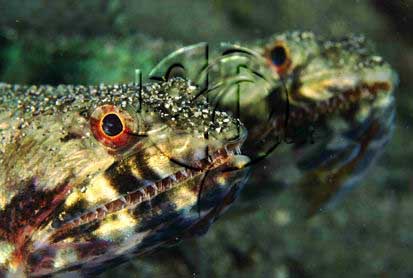|
Lizard Fish - Synodus variegatus
©
2000 by Image Quest 3-D
Read our copyright notice
Photograph by Scott Tuason Lizard fish do not seem to be willing to wait for their prey but are active hunters, moving frequently between rock platforms , from which they scan the surroundings for small fish. When the lizard fish spots its prey, its raised head is immediately lowered, and the fish hugs the sea floor, making short stalking moves, or it may wait for the victim to approach. When it is close enough the lizard fish strikes, but only about one in ten strikes is successful, and on average only two or three fish are taken every day. A missed fish will successfully reach shelter, and then is out feeding again within 30 minutes. Then it seems to be left alone by the lizard fish - as though once a small fish is aware of a predator, it does not fear being caught. Small gobies that spot a lizard fish bob up and down letting the lizard fish know that it has been seen and are not attacked, presumably because once they know the predator was there they would be able to leap away before the strike. Harrassment by larger fish, by damselfish pressing their fins into the face of the lizard fish and by labrids rushing at and biting the lizard fish, can be common. Life is clearly not easy for a small predator, but in very stormy weather, when small fish are swept about the coral by heavy surges, lizard fish have been seen to feed repeatedly and successfully on juvenile fish.
Click here to view the 'Picture of the
Week' archive.
|
||||||||
|
|
||||||||


